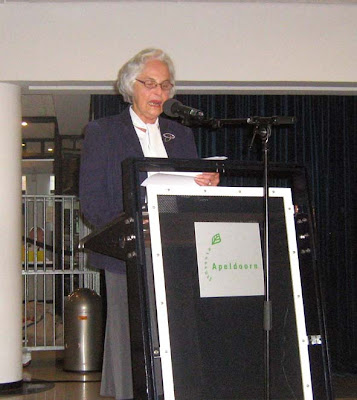 Tanggal 5 Oktober 2009, bertempat di gedung Gemente Apeldorn Belanda, atas kerja sama Yayasan Erfgoed dan SVL diadakan Seminar, pameran footo, peluncuran buku dan pemutaran film tentang peristiwa Perundingan Linggajati serta peringatan 100 th Sutan Sjahrir. Dalam kesempatan tersebut antara lain berpidato salah seorang pendiri SVL (Yayasan Persahabatan teman-teman Linggajati) Ibu Joty Terkulve. Beliau adalah kakak dari Dr Willem Os SpOG yang juga pendiri SVL. Bersama ini adalah pidatonya.
Tanggal 5 Oktober 2009, bertempat di gedung Gemente Apeldorn Belanda, atas kerja sama Yayasan Erfgoed dan SVL diadakan Seminar, pameran footo, peluncuran buku dan pemutaran film tentang peristiwa Perundingan Linggajati serta peringatan 100 th Sutan Sjahrir. Dalam kesempatan tersebut antara lain berpidato salah seorang pendiri SVL (Yayasan Persahabatan teman-teman Linggajati) Ibu Joty Terkulve. Beliau adalah kakak dari Dr Willem Os SpOG yang juga pendiri SVL. Bersama ini adalah pidatonya.-----------------------------------------------------------------------
Ladies and Gentlemen,
No country can escape its history; nor can it forget its past. But we can draw lessons from both.
The Linggajati agreement, which was signed in 1946 by
The agreement was reached by statesmen of both countries who were prepared to have a genuine meeting of minds, and who would negotiate with respect for each other. Some of the participants paid dearly in both their private and public lives.
The problems of international conferences today are not so much caused by reams of policy papers written to solve the problems; rather, most problems are in the attitudes of in the participants. As someone once remarked, there are more problems sitting around the table than are on the table. In that sense, Linggajati today is highly relevant.
Linggajati is a “bridge to the future.” This is possible only if the pillars supporting the bridge are solid, which they will be if we do not deny our colonial heritage.
After sixty years, both our countries demonstrate that the bridge will be strong. This became clear at the Seminar in Den Haag initiated by His Excellency Mr Habibi, Ambassdor of Indonesia in the
At the seminar, Mrs. Upik Syahrir, the daughter of the great statesman Sutan Syahrir, told the participants about the suffering her father and his family suffered at the hands of their Indonesian compatriots. She described how her father had been imprisoned for years—without due process—in Madioen. In my view, the fact that
Mrs. Syahrir was considerate in not mentioning that in 1933, her father, who had returned from the
She emphasized how her father could forgive those who had harmed him and that he always managed to keep faith in his country,
But Sultan Syahrir was also a father who loved his wife and children. Upik told me that when she, her mother and brother made a long trip to visit her father in Madioen, they were accompanied by an aunt. As they returned to the prison exit her aunt realized that she had forgotten something. So she returned to the cell where she found Syahrir in tears, holding a picture of his children in his hands.
When Mrs. Syahrir mentioned this experience during her talk at the seminar in den Haag, there wasn’t a dry eye in the audience. She received a standing ovation. The Dutch, the Indonesians, the Indo’s all of us recognized ourselves in Mrs. Syahrir. She showed us another lesson—that healing from past wounds is possible when people and countries face their history and past mistakes, and, together, decide to build a new future.
Ladies and gentlemen, since 1945 many things have changed. White is no longer the only beautiful skin colour. Brown, Black, we all count; we all want to be recognized for who we are, and be treated with respect. Now we must put our combined efforts in finding ways to make a multicultural society work for everyone. The reality that inside our hearts we are all alike is increasingly accepted. We have entered a new century. Mankind is confronted with overwhelming challenges. We need each other in order to successfully meet these challenges.
The younger generation needs to know more about the colonial times, the mixed culture of the Dutch–Indonesian mix; the treaty of Linggajati and what that meant for both our peoples; the exodus of the former citizens of the Dutch East Indies; the life of the Indonesian Founding Fathers, and the great Dutch statesmen, Schermerhorn, van Mook Sanders who were present.
Through Soekarno, Hatta, Sutan Syahrir and the Treaty of Linggajati, our youth in
It is note worthy to mention their success in dealing with some large natural disasters .
Ladies and gentlemen Linggajati : the bridge to the future.
Joty ter Kulve–van Os
Dr. W.A.A. van Os
Foundation ‘’ Vrienden van Linggajati”
October 2009






{ 0 komentar... Views All / Send Comment! }
Posting Komentar